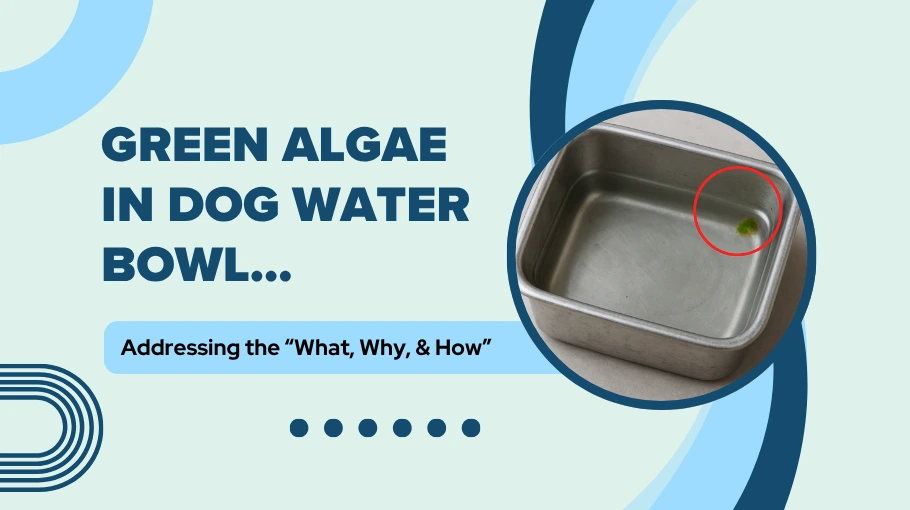Green Algae in Dog Water Bowl: What’s Up with That?

I’m going to share a story about the morning I found green algae in the dog water bowl, and why I was hunting for something unusual. Fair warning, do not read this while eating because there’s some yucky stuff about to be discussed.
The Background
It was one of those mornings that’ll be hard to forget. At 5:30 am, the alarm goes off. The other half toddles down the stairs first, because she leaves first for work. Next thing, I hear her voice echo – “you should see the mess in the living room”. I instantly know what I’m facing…
One of the dogs has had an accident. Question was, which end did it come from? I reply, “shut the door, and I’ll be down in a minute”.
As I open the door, the mess and smell could not be missed. There on the red and black rug, lay 4 brown patches, like miniature cow patties.
It’s in these times I’m glad for the Vax Rapid Power carpet cleaner. It took 6 poop bags to clear the mess, before I could prep it with the pre-treatment spray, then let the machine takeover the cleanup duty. It’s less of a stomach churner to clean the machine than it is to clean runny poop from a rug.
Now, for context, there was another accident two days prior, in the crate. I didn’t think much of it. Just thought, must be a dodgy stomach – I’ll keep an eye on him. Then, this happened.
Following the clean up, it was time to play inspector. What’s changed? They’ve not been given anything new to eat, haven’t been anywhere unusual, in fact, they were only outside in the garden yesterday. The garden had the weeds sprayed weeks back, so it wasn’t that. The neighbours hadn’t chucked any scraps over the fence either. The only thing that hadn’t been changed was the water.
About that… I have saw birds using the dogs water bowl for bathing. It got changed when I saw it. The smaller bowl the birds were using got moved down the garden. The bigger bowl was put closer to the house, off the grass, where the birds left it alone. They congregate at the bottom of the garden.
Here’s where the problem was though. At the bottom of the dogs water bowl was green algae. When I checked the one in the house, the same. Just a smidge though, right in the corner. Enough to contaminate the water, I’d suspect.
That’s what sent me on a research spree to learn more about green algae and how it affects water bowls for dogs — especially those left outside. I found that many no-spill designs use floating discs or small openings that let the dog drink, but make it harder for birds to use the bowl for bathing. A handy garden fix to keep the dogs outdoor water bowl clean during the day.
The Risks of Algae on Dog Health
Once I clocked the green algae in the water bowl, I went full detective mode. I’d already ruled out everything else — food, treats, garden exposure — so this was the last piece of the puzzle. And it turns out, green algae can actually pose some real health risks to our dogs. Here’s what I found, laid out from the most common to the rare but dangerous.
1. Tummy Trouble (Gastrointestinal Upset)
This is the most common issue. Algae-contaminated water can irritate a dog’s digestive system and cause symptoms like:
- Vomiting
- Diarrhea
- Loss of appetite
- Excessive drooling
Sound familiar? That’s exactly what we were dealing with. Even small amounts of algae can lead to upset stomachs, especially if the water’s been sitting around in warm weather.
2. Bacteria Tag-Alongs
Algae is often a breeding ground for other nasties like E. coli and Salmonella. If your dog drinks from a bowl that’s been taken over by algae, they might also be ingesting harmful bacteria. This can lead to:
- Gastro symptoms again (yep, double trouble)
- Fever
- Lethargy
Here’s the kicker — you won’t see the bacteria. And just rinsing away the green stuff isn’t enough to eliminate the risk. You need to properly clean the bowl: either with hot water, or by using something pet-safe but effective at killing bacteria, like a mix of baking soda and vinegar. It only takes a minute, but it can make a big difference.
3. Toxic Algae (Blue-Green Algae)
Now, this one’s a rare algae in dog water bowls, but it’s serious enough to mention. Some types of algae, particularly blue-green algae (cyanobacteria), are extremely toxic to dogs. Just a few sips can cause:
- Seizures
- Liver failure
- Death (yes, seriously)
It’s more commonly found in ponds and lakes, but if outdoor bowls collect rainwater or get cross-contaminated, the risk exists. Don’t let bowls sit full for too long outside. Refresh them regularly and give them a proper clean daily, especially in summer. This was a reminder that “fresh water daily” doesn’t just mean access… it means clean, regularly refreshed water.
Oh — and here’s an eye-opener I found during my research: birds can indirectly bring blue-green algae into your garden. If they’ve been in a contaminated pond or river, those toxins can hitch a ride on their feathers or feet. If they then bathe or drink from your dog’s bowl (like I saw in ours), they could contaminate it. It’s not something I’d have suspected, but it really drove home the need to stay on top of bowl hygiene in the summer months.
4. Skin Irritations
If your dog has sensitive skin or allergies, even just contact with algae-contaminated water can cause issues like:
- Itching
- Redness
- Irritation around the snout (nose area) or paws
Not every dog reacts this way, but it’s worth watching if you notice them licking or scratching more than usual after drinking.
5. Mould and Fungal Friends
Algae loves a dirty bowl and so does mould. If a bowl’s left sitting for too long, especially indoors and untouched, you could end up with a nasty combo of green slime and sneaky fungal growth.
Our two actually prefer to drink rainwater or tap water only if it’s outside, which means the indoor water bowl often goes ignored in good weather. And if it just sits there, that stale, stagnant water becomes prime territory for mould to creep in.
That’s more than just gross… it can worsen digestive upset if they drink it. And if spores become airborne, it can even lead to respiratory irritation, particularly in sensitive dogs. It’s like having a musty corner of the house, but right where your dog breathes and eats.
Tip: If your dog prefers drinking outside, make a habit of emptying and washing the indoor bowl anyway. It’s easier than the clean up will be later.
Preventing Algae Proliferation: Effective Cleaning Solutions
After the whole mess with algae-contaminated water, I realised a simple refill wasn’t going to cut it anymore. Fresh water is important, but so is the state of the bowl it’s in. That meant it was time for a clean-up routine overhaul.
The first thing I did? Loaded every bowl into the dishwasher and ran it on the Intensive 65° cycle to get them proper sanitised. If I didn’t have the dishwasher, my go-to would’ve been a mix of baking soda and vinegar, as those are safe for the dogs, but still tough on bacteria.
And if that wasn’t available? I’d have used bleach, let it soak, then rinsed it thoroughly with washing up liquid to make sure every bit of residue was gone.
Drastic maybe, but better than another morning cleaning at crazy early hours.
To stop algae creeping back in, there’ll be a few changes going forward:
- The indoor water bowl’s been moved away from the tall frosted glass window that had it baking in direct sunlight all day.
- Water gets changed daily, not left to stagnate.
- Bowls get a proper clean weekly, more often if anything looks slimy or off. Remember, in heat, green algae can appear after just a couple of days.
This was a lesson learned the hard way, but it’s made one thing clear: when people say “make sure dogs have fresh water daily,” that doesn’t just mean access to water… it means water that’s clean, in a bowl that’s not secretly brewing a science experiment.
Doing all this means one less thing that’s likely to give the dogs an upset stomach, and that alone makes it worth the effort.
Smart Placement: Keeping Bowls Away from Algae-Friendly Environments
One thing I’ve learned through this whole algae saga: where you put the bowl matters a lot!
For a while, we had a bowl out in the garden so the dogs could grab a drink while they were out sniffing about. Nice idea in theory, until the birds started using it like their own little spa. That’s when the algae showed up, and not just a bit… we’re talking green film lining the bottom. Didn’t help we just let the bowl accumulate rainwater instead of changing it every day.
The bigger steel bowl was moved closer to the house, where the birds don’t hang around as much. They tend to flock to the bottom of the garden, which is more open, so it makes sense to keep the water well away from that zone.
We also learned a lesson the hard way with an old plastic trough we used as a makeshift bowl. Thought it was a clever solution for hot days, until the entire base turned green and slimy. We had that tucked beside the building, out of the sun, but it still went rank.
Once algae takes hold in plastic, good luck cleaning it properly. We ended up chucking it. Since switching to stainless steel, it’s been easier to scrub, doesn’t stain, and just stays cleaner for longer. There’s no contest… stainless steel are the best dog water bowls because they’re easier to clean.
So here’s the takeaway:
Place the bowl somewhere that’s out of direct sunlight, and ideally if outdoors, somewhere that’s less accessible to wildlife. Shade helps slow down algae growth, and fewer bird visits means less chance of contamination.
It’s a small tweak that makes a big difference… the water stays cooler, cleaner, and far less likely to turn into an algae farm.
Beyond the Basics: Could a Raised Water Bowl Help in the Garden?
Here’s a thought that hit me while dealing with the green algae mess… you know how bird baths are usually elevated? It got me wondering if having the dog’s water bowl off the ground might help cut down on some of the problems we’ve been having outside.
Birds were part of the issue, but they weren’t the only ones showing up for a drink. We get loads of slugs and snails in the garden overnight, and it made me realise that a bowl sitting low to the ground is basically an open invite for anything that slithers, crawls, or flaps to stop by.
Now, I’m not saying raise the bowl sky-high, but lifting it a bit might help make it harder for slugs and snails to climb into. Honestly, since finding algae — and learning how birds can cross-contaminate water — it’s dawned on me that all sorts of nasties could be bathing in the dogs’ bowl when I’m not around to see it.
That said, raised bowls aren’t for every dog. I came across the bloat debate while looking into them, and it’s definitely something to be aware of, especially with bigger breeds. Some say elevated bowls can increase the risk, while others swear by them for dogs with joint issues or mobility problems.
So for me, it’s about context. Indoors, I’ll keep the bowls low. But outside? I think a raised perch will be a bird bath for the birds — one the dogs can’t reach — and when we’re out in the garden all day, I’ll put a spare dog bowl out for them too, somewhere shaded. But never again overnight. Lesson learned.






